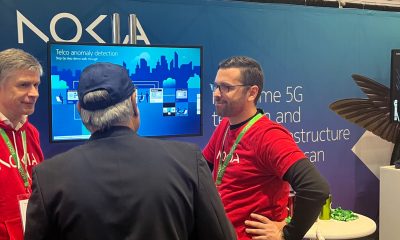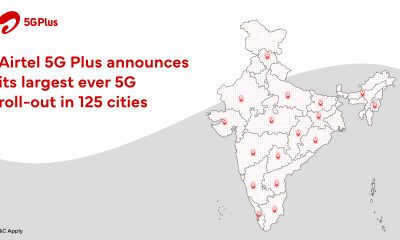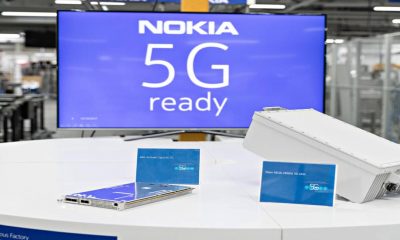5g
By 2025 India to join China, U.S. Japan, South Korea and United Kingdom to offer 5G mobile connections
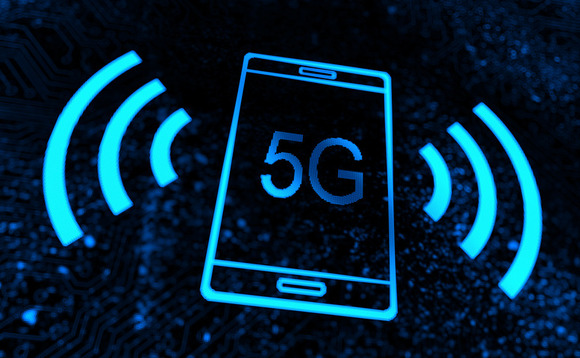
NEW DELHI: Broadband India Forum (BIF) and Policy Impact Partners today announced that it had released a global benchmark analysis of 5G policies and initiatives.
The white paper was released by Minister of Communications, Manoj Sinha at the 5G India 2018 International Conference taking place in Mumbai today.
Broadband India Forum also announced that progressive public-private partnerships between the government and industry can ensure that India joins the list of early adopters of 5G services – nations such as China, USA, UK, Japan and South Korea.
The Global Benchmark Analysis, carried out by Policy Impact Partners, a reputed international consultancy focused on digital and connectivity issues, is a comparative overview of the 5G policies and market development initiatives promoted by the five countries considered to be global leaders in 5G: China, Japan, South Korea (Republic of Korea), the United Kingdom, and the United States.
Releasing the global benchmark analysis, Shri Manoj Sinha, Hon’ble Minister of Communications said, “India has much to gain from rising to the 5G challenge and a tremendous opportunity to accelerate its own ambitions. It can learn from the experiences of early leaders to establish a cohesive 5G roadmap that can help drive the Digital India strategy and enable the country to distinguish itself as a challenger in shaping 5G technologies.
The Government of India has a unique opportunity to leverage the power of 5G to drive forward the Digital India agenda, accelerating economic growth and societal development. Policies and regulation must focus on incentivizing a quantum change in investment and accelerating the deployment and take up of innovative 5G services.”
Aruna Sundararajan, Secretary Telecom, Government of India said, “The global benchmark analysis report by the Broadband India Forum highlights some salient indicators which other leading economies of the world are pursuing. These should help India to take a leaf out of their book to spur a harmonious and accelerated roll-out of 5G services by 2025, in tandem with other leading proponents of this platform. We are committed to India being an early adopter of the 5G platform and to enable this, are committed to working closely with industry and other key stakeholders to ensure that we lay the right foundations of this technology.”
T.V. Ramachandran, President, Broadband India Forum said, “The Global Benchmark Analysis reveals one common factor – that across each of the countries benchmarked, there is strong political commitment to 5G and this translates into institutional mechanisms and collaboration platforms with industry. We’re seeing globally that partnerships are critical to the success of 5G, both between the telecom sector, wider industry and the government. The potential of India to be an early adopter of this technology is second to none.”
He further added, “We are thankful to the Department of Telecommunications (DoT), Government of India for the support provided to 5G India 2018. 5G is a key thrust area for DoT and it is leaving no stone unturned to ensure that India remain at par with its global peers with regards to the adoption of 5G. DoT has also been actively involved in enabling the 5G demos that have been held by various companies and academic institutes.”
Key Points of the Global Benchmark Analysis of 5G Policies and Initiatives
Momentum towards 5G is building as standards work accelerates and test and trialling activity ramps up. Governments, operators and vendors are striving to lead on 5G in order to achieve a competitive advantage and secure maximum benefits. Commercial roll-outs are expected across all 5G leader markets by 2020, with operators in the U.S. and South Korea targeting 2019 deployments.
By 2025 5G will be a significant part of the connectivity mix with the GSMA forecasting that it will account for 49% of total connections in the U.S. (excluding cellular IoT), 45% in Japan and 25% in China. China, the U.S. and Japan will together host more than 70% of the world’s forecasted 1.2 billion 5G mobile connections.
A successful 5G strategy requires a combination of cost effective infrastructure roll out and the development of business cases that leverage 5G´s superior capabilities. The investment and innovation needed will be driven by industry but, as evidenced in this report, governments and regulators across the 5G leadership countries are playing a key role in setting the right conditions for investment to grow and innovation to thrive.
While licensed operators running cellular infrastructure will be at the heart of 5G connectivity, future networks will rely on a combination of Satellite, Wi-Fi and High Altitude Platform Systems (HAPS) especially in the Indian context. Each technology will bring key attributes to the delivery of ubiquitous 5G services.
This global benchmark analysis also pointed to a number of key policy considerations that are consistently prioritised by countries headed the 5G way. Broadband India Foundation believes that India needs to benchmark against these efforts, repeat best practice where it can, and prioritise the following actions:
Complement the Digital India and Make in India initiatives through a sustained cross-departmental, cross-sector strategy to ensure the country seizes its 5G opportunity.
Develop a 5G roadmap with targets and milestones to provide the necessary political focus and help mobilise the requisite resources.
Act as a catalyst for, and an early adopter of, 5G in areas such as health, transport, and the full range of public services that underpin smart communities.
Make more harmonised spectrum available at both high and low frequencies, and award it in ways that target long-term growth, investment and citizen welfare, rather than short-term revenue maximisation.
Clear spectrum for exclusive use where timely clearing is possible but otherwise explore options for dynamic sharing.
Maximise spectrum output by ensuring licences are of adequate length and carry clear renewal criteria, and that spectrum fees are limited with a view to promote innovation and economic development and for ensuring efficient and effective use.
Make spectrum available on a technology neutral basis, and provide the right balance of licensed and license-exempt solutions. For example, in high frequency spectrum it is critical for India to make the V-band (57-64 GHz) available for unlicensed use for indoor applications along with a mix of unlicensed and light-licensed usage for outdoor applications as a complement to licensed 5G bands.
Reduce obstacles to 5G deployment including high costs and administrative delays in accessing cell sites or fibre ducts, and locally imposed, overly restrictive EMF limits.
Ensure the regulatory framework provides the necessary certainty and predictability for investors, and refocus regulation and competition policy on delivering high performance markets for consumers long-term benefit.
Enable the quality differentiation made possible through 5G by allowing network operators to manage their networks optimally and to innovate in the provision of services that meet specific use case and end user requirements.
Develop an overarching testbed and trials programme as a key driver for building India’s 5G ecosystem, and ensure accelerated spectrum availability for testing purposes.
Recognise that many different technologies will need to come together to ensure delivery of the full range of 5G capabilities and ensure all technologies can compete and fulfil their potential in contributing to the 5G mix.
5g
MediaTek Catch-up with Tech: Infinix Zero 30 5G with Dimensity 8020 launched

NEW DELHI: Chipset maker MediaTek, which claims to power more than two billion connected devices every year, hosted ‘Catch-up with Tech’ in collaboration with handset brand Infinix on August 28 to share insightful and engaging conversations about the new-age smartphones and innovative technologies powering everyday lives.
The meet-up threw the spotlight on the MediaTek Dimensity Auto, Satellite solutions and Generative AI along with an extensive showcase of newly-launched Infinix Zero 30 5G powered by MediaTek Dimensity 8020, Infinix GT 10 Pro powered by MediaTek Dimensity 8050, and Infinix QLED TV powered by MediaTek.
In terms of specs, the Infinix Zero 30 5G is tailored for young storytellers and creators, featuring the first-ever smartphone to deliver 4K 60fps video recording from its 108 MP OIS rear camera and ultra-high resolution 50MP front camera. The Zero 30 series powered by MediaTek Dimensity 8020 is said to be a game changer for the front camera vlogging experience along with being the slimmest curved AMOLED smartphone in the segment with glass and a vegan leather back panel. It also claims to be one of the most premium-looking devices in the segment.
The event witnessed a panel discussion moderated by Anuj Sidharth, Deputy Director Marketing & Corporate Communications, MediaTek and included expert panelists from Infinix, MediaTek and two renowned professional photographers.
“With the fifth edition of Catch-up with Tech, we aim to bring consumers closer to the technology and enable them to make informed buying decisions based on their diverse needs. In collaboration with Infinix, this meet-up is in-line with MediaTek’s vision of technology democratization and making innovative technology accessible to everyone,” said Anku Jain, Managing Director, MediaTek India. “The MediaTek Dimensity 8020 in Infinix Zero 30 5G brings faster displays, brilliant cameras and ultra-fast performance. Further, MediaTek Imagiq technologies enrich the capture experience by combining dedicated AI, imaging processors and accelerators to provide incredible results,” he added.
Anish Kapoor, CEO, Infinix Mobile India, said, “Featuring India’s first 50MP 4K 60 fps video recording, Infinix Zero 30 5G is primed to redefine smartphone imaging capabilities, setting a new standard for the creators and vlogging enthusiasts. Our collaboration with MediaTek has played a pivotal role in shaping our exceptional smartphone portfolio, and the Zero 30 5G stands as evidence of our unwavering commitment to innovation and delivering unmatched experiences to our users. The display and design of the device represent a leap forward in smartphone technology. As Infinix Zero 30 5G hits the shelves, we are positive that our customers will find this new offering as exhilarating as we do, further empowering creators to capture their story like never before.”
Radhakrishnan Chakyat, a photography evangelist, founder and host of Pixel Viilage, said, “Infinix Zero 30 5G smartphone powered by MediaTek Dimensity 8020 chipset has amazing hardware features, an excellent camera, dual-view video mode and is primed for optimal content creation and saves a tremendous amount of editing time.”
Aarzoo Khurana, a wildlife photographer, said, “Over the last few days, I clicked various pictures and recorded a few videos with the newly-launched Infinix Zero 30 5G powered by MediaTek Dimensity 8020, and the experience has been truly inspiring. Infinix’s smartphone’s OIS feature helps content creators click shake-free pictures and the front camera, which is extremely sharp and detailed, enables content creators to click countless selfies.”
5g
Nokia launches Nokia MEA Mobile Broadband Index confirming 5G drives digital transformation
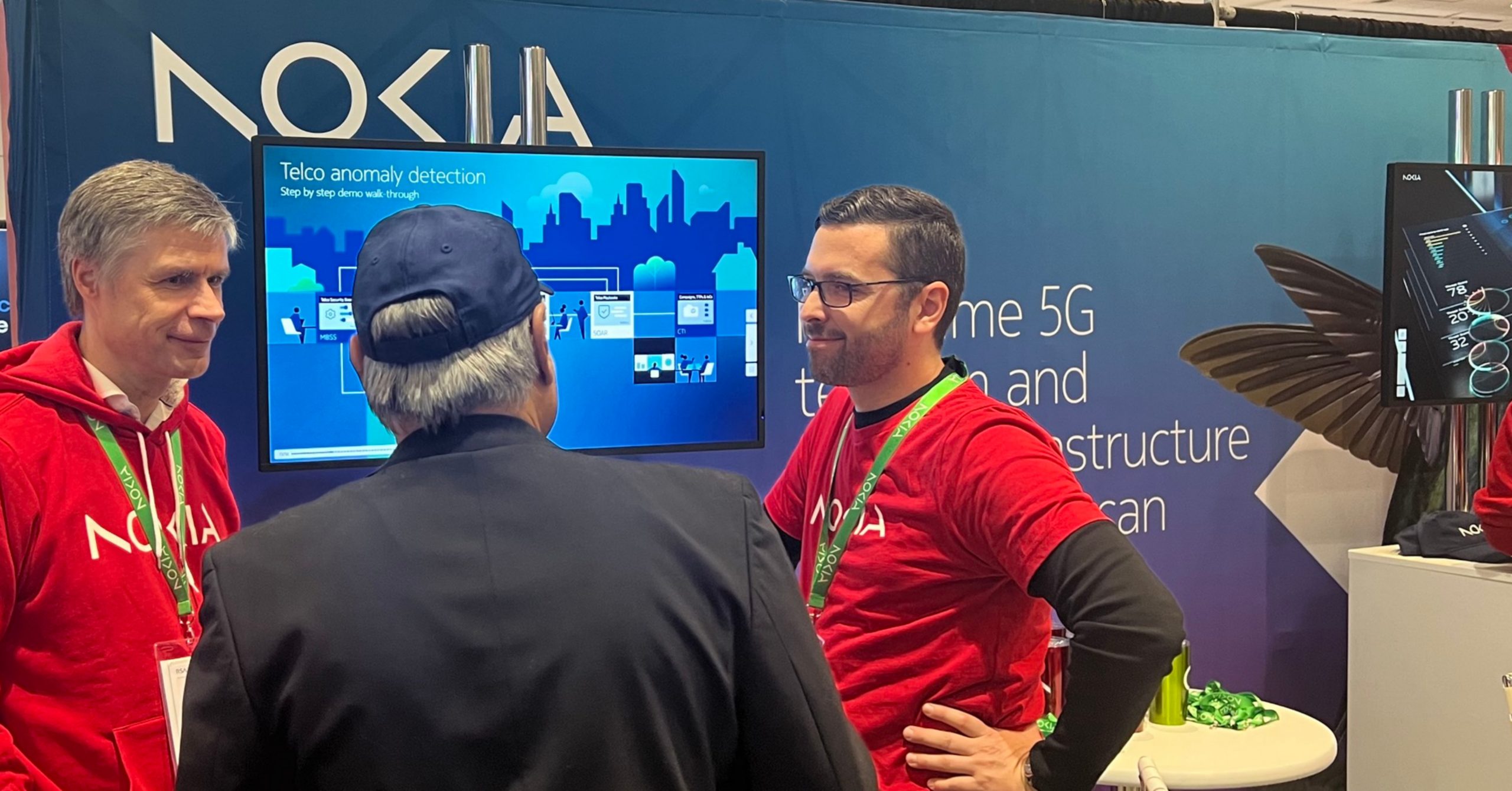
NEW DELHI: Nokia has announced the results of its new research report, the Nokia MEA Mobile Broadband Index, which provides a comprehensive overview of the MEA region’s mobile broadband landscape. The in-depth report highlights the steady growth of 5G in the Middle East and Africa region (MEA) as well as its impact on digital transformation.
It confirms that the Middle East is far ahead of Africa in terms of 5G adoption, while many operators in Africa are still developing their business models around 4G. Voice traffic still relies on 2G and 3G networks in many parts of the region.
5G is forecast to increase steadily and will contribute to the growth of the mobile broadband subscriber base, which is expected to grow with a CAGR of six percent in MEA. According to the report, 4G networks in MEA account for 79 percent of overall data traffic today, and by 2027, 4G and 5G will together account for 90 percent of data traffic. In the same year, 4G subscribers will reach 1,214 million (53 percent of total subscribers) whereas 5G adoption is estimated to reach 380 million subscribers (17 percent of total). Yearly ARPU is estimated to increase at USD$3.4 in 2027, and total data traffic is expected to increase at a CAGR of 32 percent from 2022 to 2027.
The report shows that in the Gulf Cooperation Council (GCC) region, 5G adoption is the fastest, and 5G subscribers are expected to reach 75 percent by 2027, mainly driven by Saudi Arabia. In non-GCC Middle Eastern countries and in Africa, 4G will continue to expand and remain dominant until 2027, while 5G deployment is at nascent stage today and poised to gain more and more momentum over the next years.
As the report confirms, 5G Fixed Wireless Access (FWA) in the GCC countries and 4G FWA in the rest of the MEA region are one of the most attractive use cases, with a significant opportunity for operators to drive incremental revenues. Furthermore, 5G networks are more energy efficient than previous radio network generations, helping operators reach their sustainability targets.
Mikko Lavanti, Head of Mobile Networks at Nokia MEA, said: “MEA is a diverse region with many countries at different stages of development and that is reflected in our report. Data consumption with high-speed networks is increasing exponentially across the MEA market in both urban and rural areas. Reliable 4G and 5G networks are critical for bridging the digital divide in the region, in addition to supporting data-intensive applications for communities and businesses. Nokia is helping both operators and enterprises unlock new opportunities with 5G, building the evolution towards future technologies that will enable enhanced experiences such as the Metaverse.”
5g
Airtel announces its largest ever 5G roll-out in 125 cities
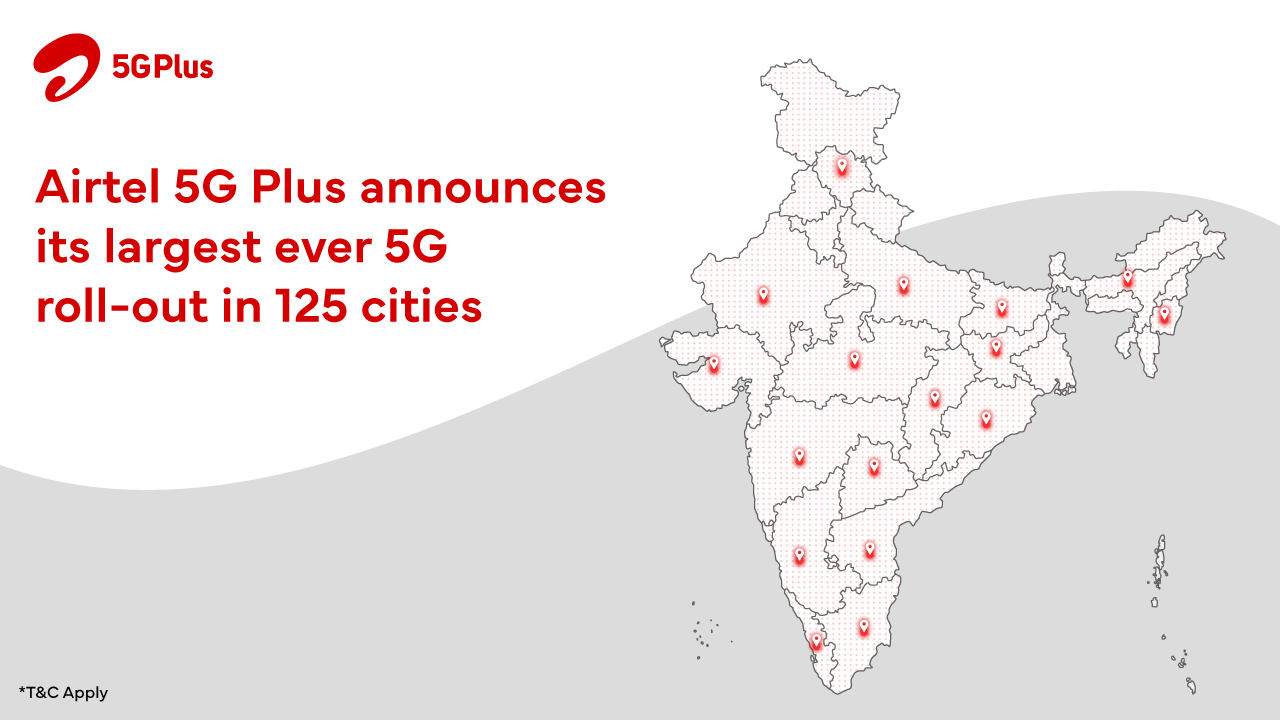
NEW DELHI: Bharti Airtel, India’s telecommunications services provider, today announced the launch of its ultra-fast 5G services in 125 cities. Airtel 5G Plus service is now available to customers in over 265 cities in the country.
Airtel 5G Plus has three compelling advantages for customers. First, it runs on a technology that has the widest acceptance in the world with the most developed ecosystem. This ensures that all 5G smartphones in India seamlessly work on the Airtel network. Second, the company promises to deliver the best experience – between 20 to 30 times higher speeds than today coupled with brilliant voice experience and super-fast call connect. Finally, Airtel 5G Plus network will also be kinder to the environment with its special power reduction solution. Powered by the reliable Airtel network infrastructure, Airtel 5G Plus will provide superfast access to High-Definition video streaming, gaming, multiple chatting, instant uploading of photos et all.
Commenting on the launch, Randeep Sekhon, CTO, Bharti Airtel said, “5G has revolutionized the world of internet, ushering new era of connectivity and communications that will prove to be a game-changer for the country. At Airtel, we remain committed to delivering the highest quality of network and service to our customers as we roll-out 125 more cities today. Airtel was the first in the country to offer 5G services in October 2022, and today’s mega launch is our promise to connect every Airtel customer in the country with ultra-fast Airtel 5G Plus. Our 5G rollout is on track to cover all towns and key rural areas by March 2024.”
Airtel 5G Plus service availability will continue to rapidly expand – including service in all towns and villages in the country soon – as the company is working towards offering nationwide coverage. Airtel is now offering its 5G services in every major city from the upper northern city of Jammu to the southern tip of Kanyakumari.
In the last one year, Airtel has demonstrated the power of 5G with a host of powerful use cases that will change the way customers lead their lives and do business. From India’s first live 5G network in Hyderabad to India’s first private 5G network at the BOSCH facility in Bengaluru to partnering with Mahindra & Mahindra to make its Chakan manufacturing facility, India’s first 5G enabled auto manufacturing unit, Airtel has been at the forefront of 5G innovation.



